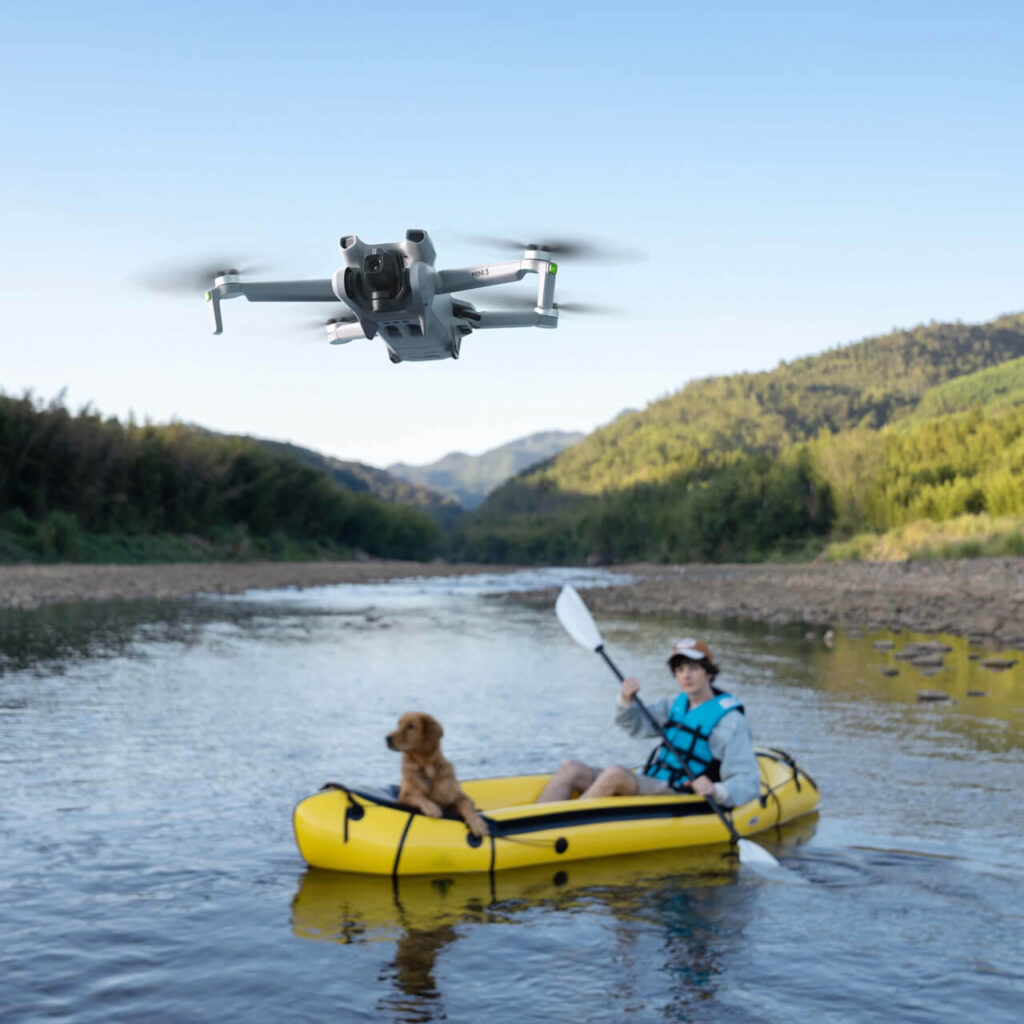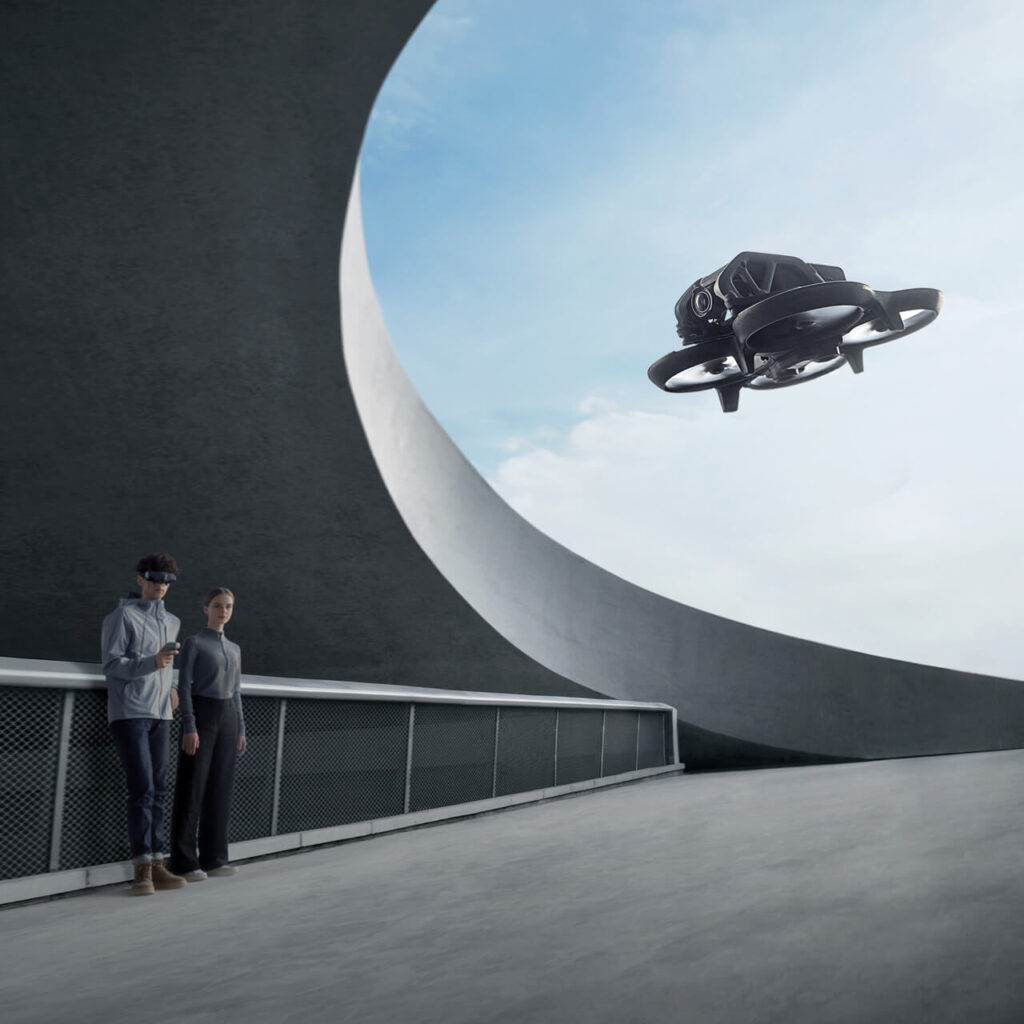Thermal drones have moved from niche tech to essential tools across many industries. Whether you’re inspecting solar panels, monitoring livestock health, managing firefighting operations, or handling perimeter surveillance, a drone with thermal imaging gives you powerful eyes in the sky day or night.
But here’s the challenge: With so many brands and models out there, how do you know which thermal drone is actually worth the investment?
In this guide, we break down the smartest picks for 2025, across budgets and business needs. You’ll discover:
- Top-rated thermal drones used in India and worldwide
- Models from trusted brands like DJI, Autel, Parrot, Skydio, and more all available via Jetayu Gadgets, a multi-brand drone seller
- Which drones suit which industries from agriculture to infrastructure to emergency response
- What features to compare before buying
If you’re a professional or business team looking to make the right purchase, this blog will help you cut through the clutter and choose with confidence.
What Is a Thermal Drone and How Does It Work?
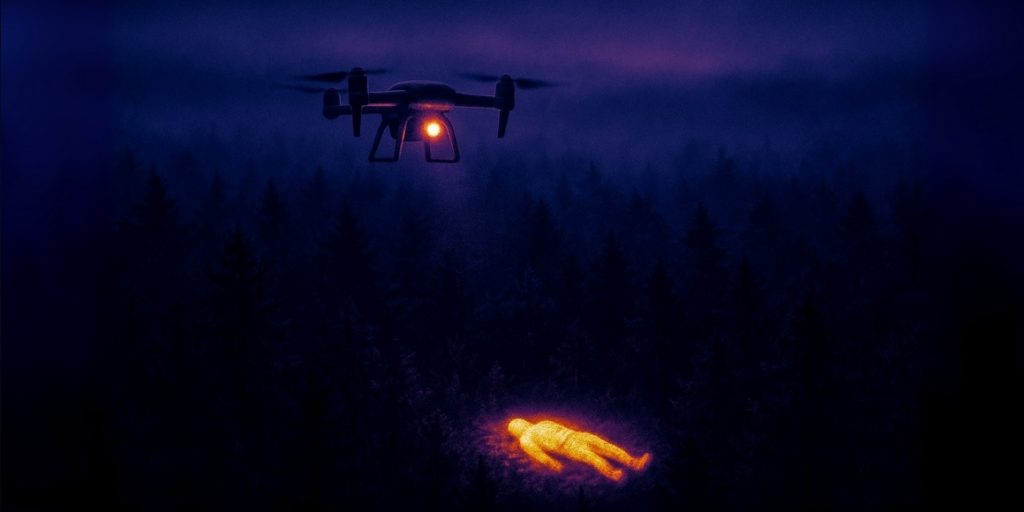
A thermal drone is equipped with an infrared camera that detects temperature differences instead of visible light. This allows it to “see” heat patterns even in complete darkness, smoke, fog, or thick vegetation.
How It Works
- Thermal cameras read infrared radiation emitted by objects
- Warmer objects appear in brighter tones (like white or yellow)
- Cooler areas show up in darker shades (blue or purple)
- This data is then converted into a visible heat map or thermal image
Why Thermal Drones Are So Useful
- They spot heat leaks in buildings or electrical faults
- Help find missing persons in search-and-rescue missions
- Monitor crop health and livestock in farming
- Detect intrusions in surveillance or border security
- Survey hard-to-reach or dangerous terrain like volcanoes or flood zones
While some thermal drones are dual-sensor (visible + thermal), others focus solely on infrared imaging. If you’re starting out, you might find it helpful to first understand your needs. For example, some users may not need full thermal capabilities if their use case aligns more with content creation, where tools like the DJI Fly More Combo excel.
Top Industries That Use Thermal Drones in 2025
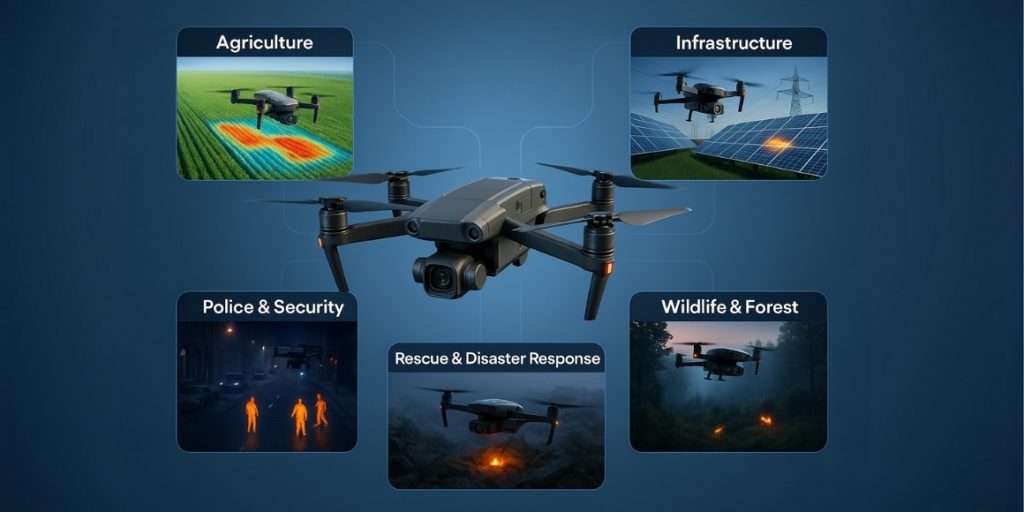
Thermal drones are no longer reserved for just military or elite rescue teams. In 2025, they’ve become powerful tools for a wide range of industries helping teams work faster, safer, and smarter.
1. Agriculture
Farmers now rely on thermal drones to:
- Monitor irrigation levels and detect dry patches
- Spot early signs of plant disease or pest activity
- Track livestock movement and health
These drones give real-time heat data over vast fields, helping reduce water usage and improve yields. In fact, with India’s growing agri-tech adoption, many experts believe drones could help address parts of the labour crisis in farming.
2. Infrastructure & Power Utilities
Thermal drones are essential for:
- Inspecting solar panels for faulty cells
- Checking high-voltage transmission lines without sending teams up towers
- Identifying heat loss in buildings
This prevents equipment failure, reduces downtime, and improves worker safety. With new policies around drone licensing in India, companies are now scaling their use faster than ever.
3. Police & Security Forces
Security agencies and law enforcement are turning to thermal drones to:
- Monitor restricted zones during night patrols
- Detect unauthorized activity along borders or perimeters
- Assist in crowd surveillance at large events
A notable example: the Gujarat Police recently launched a high-tech drone initiative using thermal imaging for smarter city patrols.
4. Disaster Response & Rescue
When visibility is poor like during wildfires, floods, or landslides thermal drones can:
- Locate survivors quickly by detecting body heat
- Map dangerous zones without risking human lives
- Deliver real-time data to rescue teams
In regions like the Northeast, where terrain and weather are unpredictable, drones have become key responders during flood and landslide crises.
5. Wildlife & Forest Monitoring
Forest departments and NGOs use thermal drones to:
- Track poachers at night
- Monitor endangered species without disturbing them
- Prevent illegal logging by spotting heat traces from tree cutters
Several Indian states are already deploying these in combination with AI-based surveillance systems. Some even collaborate with canine units, forming an innovative “dogs on ground, drones in sky” tracking system.
Best Thermal Drones in 2025 (Top Models to Consider)
Choosing the right thermal drone depends on your use case whether you’re managing a high-risk construction zone, patrolling borders, or monitoring a solar farm. Below is a carefully selected list of top-performing thermal drones for 2025 that cover a range of industries, budgets, and applications.
Each of these drones features a thermal sensor (most commonly 640×512 resolution) and is built for professional-grade missions. Most of these models are available at Jetayu Gadgets, your trusted seller of multi-brand drones in India.
15 Best Thermal Drones for Professionals in 2025
| Drone Model | Thermal Sensor Resolution | Best For | Brand |
|---|---|---|---|
| DJI Matrice 350 RTK + H20T | 640×512 | Industrial inspection, firefighting | DJI |
| DJI Matrice 30T | 640×512 | Emergency response, search and rescue | DJI |
| DJI Mavic 3T | 640×512 | Compact mapping and thermal surveillance | DJI |
| Autel EVO Max 4T | 640×512 | Construction, security monitoring | Autel Robotics |
| Autel EVO II Dual 640T V3 | 640×512 | Solar farm, industrial fire detection | Autel Robotics |
| Parrot Anafi USA | 320×256 | Tactical surveillance, public safety | Parrot |
| Skydio X10 (Thermal Variant) | 640×512 | Telecom and power grid inspection | Skydio |
| DJI Matrice 300 RTK + Zenmuse H20T | 640×512 | Utility, oil & gas, precision inspection | DJI |
| FLIR SkyRanger R70 | 640×512 | Border patrol, high-altitude missions | Teledyne FLIR |
| SenseFly eBee X + Duet T | 640×512 | Agriculture, environmental scanning | AgEagle / SenseFly |
| Quantum Trinity Pro (Thermal Payload) | 640×512 | Long-range thermal mapping | Quantum Systems |
| Freefly Astro + Workswell WIRIS Pro | 640×512 | R&D, infrastructure analysis | Freefly Systems |
| Walkera Voyager 5 | 640×512 | Extended endurance operations | Walkera |
| Hexaero Aries M300T | 640×512 | Extreme climate inspections | Hexaero |
| Ziyan Blowfish A3 (Tethered) | 640×512 | Crowd control, perimeter monitoring | Ziyan UAV |
Note: All drones listed here are designed for professional or enterprise use. For beginners or creators exploring visual drones, lighter options like the Mini 4 Pro or the anticipated Mini 5 may be more suitable depending on your goals.
Jetayu Gadgets offers consultation and post-purchase support for many of the models listed above helping businesses choose the right tool for their specific field requirements.
How to Choose the Right Thermal Drone for Your Needs
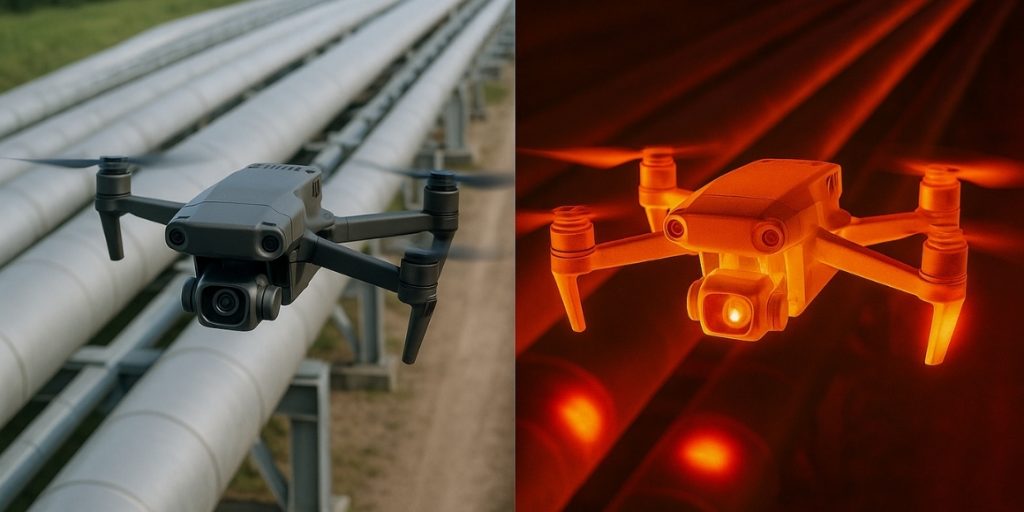
Investing in a thermal drone isn’t just about picking the one with the highest resolution. It’s about choosing a model that aligns with your industry, mission, and budget. Here’s what to look at before making a decision.
1. Thermal Sensor Resolution
The higher the resolution, the more detailed the thermal image. For most professional applications, 640×512 is the standard.
- 640×512: Ideal for industrial, emergency, and inspection work
- 320×256: Suitable for basic surveillance or low-altitude scans
If your work involves spotting fine heat differences like in solar inspections or wildlife monitoring go for the higher resolution.
2. Flight Time & Range
Depending on your needs, endurance and range matter.
- 15–30 mins: Good for tactical or quick-response use
- 30–55 mins: Better for large field scans, infrastructure, or border patrol
- Tethered drones (like the Ziyan Blowfish) offer unlimited power but limited mobility
Need something more mobile for vlogging or short missions? The Mavic or Mini series from DJI offer great range and compact handling.
3. Camera Combo (Thermal + Visual)
Dual-camera systems let you toggle between:
- RGB (visual camera) for navigation and recording
- Thermal camera for heat maps
Models like the Mavic 3T or Autel EVO II 640T combine both, so you don’t need multiple units in the field.
4. Software & AI Capabilities
Modern drones aren’t just flying cameras. Look for:
- Smart tracking
- Area mapping
- AI-based object recognition
Some drones integrate directly with platforms like DJI Pilot, while others support third-party tools for agriculture analysis or infrastructure modeling.
For creators or content-based users, knowing how to set up your drone for cinematic shots can turn a tool into an asset.
5. Durability & Environmental Tolerance
If your drone will fly in extreme heat, cold, rain, or dusty zones, make sure it has:
- IP-rated waterproofing
- Wind resistance (especially above 10 m/s)
- Heat and cold tolerance for sub-zero or desert operations
For instance, the Hexaero Aries M300T is designed for high-performance in harsh conditions.
6. Price & ROI
Thermal drones aren’t cheap but they pay off when used correctly.
- Entry-level models start around ₹3–6 lakhs
- Advanced units can exceed ₹15–20 lakhs depending on payload
Renting is also becoming a viable model, especially for short-term projects.
Why Buy Thermal Drones from Jetayu Gadgets?
When it comes to investing in a high-performance thermal drone, choosing the right seller matters just as much as choosing the right model. That’s where Jetayu Gadgets comes in a trusted name in India’s drone retail ecosystem, known for offering a full range of multi-brand drones backed by expert guidance and reliable service.
What Sets Jetayu Gadgets Apart?
1. Multi-Brand Expertise
Jetayu isn’t tied to a single brand. That means you get unbiased help choosing the right drone across top players like:
- DJI
- Autel Robotics
- Parrot
- Skydio
- FLIR / Teledyne
- Quantum Systems and more
Whether you’re comparing the Matrice 350 to the EVO Max 4T, or weighing the benefits of dual sensors versus payload capacity, Jetayu helps you make a decision based on your real-world needs.
2. Tailored for Indian Industries
Jetayu Gadgets understands local conditions. Their team has worked with:
- Agri-tech firms exploring crop monitoring
- Builders investing in drone-based surveys
- Law enforcement teams deploying thermal security units
- Forest officers tackling illegal logging and wildlife rescue
They don’t just sell drones they help you deploy them effectively.
3. Support Beyond the Sale
Unlike many online retailers, Jetayu offers:
- Product consultation before purchase
- Onboarding support and training
- Repair and upgrade options
- Easy verification of whether your unit is new or refurbished
Whether you’re just starting out or planning to sell your old drone for an upgrade, Jetayu’s support ecosystem makes the journey smoother.
4. Flexibility for All Users
- Want to test before you buy? Jetayu supports drone rental for short-term missions.
- Building a drone fleet? They offer bulk orders and institutional pricing.
- Need something lightweight for creators or explorers? Jetayu also stocks camera drones that excel in travel and storytelling, not just thermal work.
FAQs About Buying Thermal Drones in India
1. Are thermal drones legal to use in India?
Yes, thermal drones are legal in India, but their usage is regulated. You’ll need to comply with DGCA guidelines, which may include obtaining a Remote Pilot Certificate, registering your drone on the Digital Sky platform, and ensuring you follow operational limits based on the drone’s weight and category.
2. Can thermal drones fly at night?
Yes, one of the biggest advantages of thermal drones is their ability to operate in low-light or no-light conditions. They’re widely used for night surveillance, search and rescue, and wildlife tracking where visibility is a challenge.
3. What’s the typical price range for a thermal drone in 2025?
Professional thermal drones start at around ₹3–4 lakhs and can go up to ₹20 lakhs or more depending on camera resolution, flight time, AI features, and payload capacity. Prices vary significantly between models and brands.
4. Do I need a dual camera setup or just thermal?
A dual setup (visual + thermal) is more versatile. It lets you capture standard video and thermal footage simultaneously, which is valuable for inspections, mapping, and reporting. Most modern enterprise drones include both as standard.
5. What industries benefit most from thermal drones?
Industries like agriculture, solar energy, infrastructure, defense, police, and disaster response benefit the most. These sectors use thermal imaging to detect heat loss, monitor systems, improve safety, and gain insights that are invisible to the naked eye.


